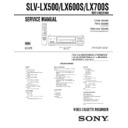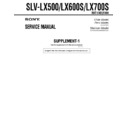Read Sony SLV-LX500 / SLV-LX700S Service Manual online
Chile Model
Peru Model
SLV-LX700S
Mexican Model
SLV-LX500/LX600S/LX700S
SERVICE MANUAL
VIDEO CASSETTE RECORDER
TS-10 MECHANISM
Refer to the SERVICE MANUAL of VHS MECHANI-
CAL ADJUSTMENT MANUAL VII for MECHANICAL
ADJUSTMENTS. (9-921-790-11)
SPECIFICATIONS
SLV-LX500/LX600S/LX700S
RMT-V403/V404
System
Format
VHS NTSC standard
Video recording system
Rotary head helical scanning FM system
Video heads
Double azimuth four heads
Video signal
NTSC color, EIA standards
Tape speed
SP: 33.35 mm/s (1
inches/s)
EP: 11.12 mm/s (
inches/s)
LP: 16.67 mm/s (
inches/s),
playback only
Maximum recording/playback time
8 hrs. in EP mode (with T-160 tape)
Rewind time
Approx. 1 min (with T-120 tape)
Tuner section
Channel coverage
VHF 2 to 13
UHF 14 to 69
CATV A-8 to A-1, A to W, W+1 to W+84
Antenna
75-ohm antenna terminal for VHF/UHF
3
8
7
16
11
16
1
2
3
4
5
6
7
8
9
0
Photo: SLV-LX700S
RMT-V404
Inputs and outputs
LINE IN 1 (entrada de línea 1) and LINE-2 IN (entrada de
línea 2)
línea 2)
VIDEO IN (entrada de video), phono jack (1 each)
Input signal: 1 Vp-p, 75 ohms, unbalanced, sync
negative
negative
AUDIO IN (entrada de audio), phono jacks (2 each)
Input level: 327 mVrms
Input impedance: more than 47 kilohms
LINE OUT (salida de línea)
VIDEO OUT (salida de video), phono jack (1)
Output signal: 1 Vp-p, 75 ohms, unbalanced, sync
negative
negative
AUDIO OUT (salida de audio), phono jacks (2)
Standard output: 327 mVrms
Load impedance: 47 kilohms
Output impedance: less than 10 kilohms
Timer section
Clock
Quartz locked
Timer indication
12-hour cycle
Timer setting
8 programs (max.)
General
Power requirements
SLV-LX700S CS
110 – 240 V AC, 50/60 Hz
110 – 240 V AC, 50/60 Hz
Other models
120 V AC, 60 Hz
120 V AC, 60 Hz
Power consumption
16 W
Operating temperature
0°C to 45°C (32°F to 113°F)
Storage temperature
–20°C to 60°C (–4°F to 140°F)
Dimensions including projecting parts and controls
(w/h/d)
(w/h/d)
SLV-LX700S/SLV-LX600S
Approx. 360 × 95 × 258 mm
SLV-LX500
Approx. 360 × 95 × 250 mm
Mass
Approx. 2.6 kg
Supplied accessories
Remote commander (1)
Size AA (R6) batteries (2)
75-ohm coaxial cable with F-type connectors (1)
Plug adaptor (1)
(SLV-LX700S CS only)
(SLV-LX700S CS only)
Audio/video cable (3-phono to 3-phono) (1)
(SLV-LX700S and SLV-LX600S only)
(SLV-LX700S and SLV-LX600S only)
Design and specifications are subject to change without
notice.
notice.
— 2 —
SAFETY CHECK-OUT
1. Check the area of your repair for unsoldered or poorly-soldered
connections. Check the entire board surface for solder splashes
and bridges.
and bridges.
2. Check the interboard wiring to ensure that no wires are
“pinched” or contact high-wattage resistors.
3. Look for unauthorized replacement parts, particularly transistors,
that were installed during a previous repair. Point them out to
the customer and recommend their replacement.
the customer and recommend their replacement.
After correcting the original service problem, perform the following
safety checks before releasing the set to the customer:
safety checks before releasing the set to the customer:
4. Look for parts which, though functioning, show obvious signs
of deterioration. Point them out to the customer and recommend
their replacement.
their replacement.
5. Check the B+ voltage to see it is at the values specified.
SAFETY-RELATED COMPONENT WARNING!!
COMPONENTS IDENTIFIED BY MARK
0
OR DOTTED
LINE WITH MARK
0
ON THE SCHEMATIC DIAGRAMS
AND IN THE PARTS LIST ARE CRITICAL TO SAFE
OPERATION. REPLACE THESE COMPONENTS WITH
SONY PARTS WHOSE PART NUMBERS APPEAR AS
SHOWN IN THIS MANUAL OR IN SUPPLEMENTS
PUBLISHED BY SONY.
OPERATION. REPLACE THESE COMPONENTS WITH
SONY PARTS WHOSE PART NUMBERS APPEAR AS
SHOWN IN THIS MANUAL OR IN SUPPLEMENTS
PUBLISHED BY SONY.
— 3 —
TABLE OF CONTENTS
Important Service Guide
◆ Mode Switch (Program Switch) Assembly Point ························· 4
◆ How to eject the cassette tape
◆ How to eject the cassette tape
(If the tape is stuck in the unit) ·············································· 4
1.
General
Getting Started
Step 1 : Unpacking ····························································· 1-1
Step 2 : Setting up the remote commander ························· 1-1
Step 3 : Hookups ································································ 1-2
Step 4 : Setting the clock ···················································· 1-4
Step 5 : Selecting a language ·············································· 1-4
Step 6 : Presetting channels ················································ 1-4
Step 2 : Setting up the remote commander ························· 1-1
Step 3 : Hookups ································································ 1-2
Step 4 : Setting the clock ···················································· 1-4
Step 5 : Selecting a language ·············································· 1-4
Step 6 : Presetting channels ················································ 1-4
Basic Operations
Playing a tape ····································································· 1-5
Recording TV programs ····················································· 1-6
Recording TV programs using the Dial Timer ··················· 1-7
Recording TV programs using the timer ···························· 1-8
Locking the VCR (Child Lock) ·········································· 1-9
Recording TV programs ····················································· 1-6
Recording TV programs using the Dial Timer ··················· 1-7
Recording TV programs using the timer ···························· 1-8
Locking the VCR (Child Lock) ·········································· 1-9
Additional Operations
Playing/searching at various speeds ··································· 1-9
Setting the recording duration time ···································· 1-9
Checking/changing/canceling timer settings ···················· 1-10
Recording stereo and bilingual programs ························· 1-10
Searching using various functions ···································· 1-10
Adjusting the picture (tracking) ······································· 1-11
Changing menu options ···················································· 1-11
Editing with another VCR ················································ 1-12
Setting the recording duration time ···································· 1-9
Checking/changing/canceling timer settings ···················· 1-10
Recording stereo and bilingual programs ························· 1-10
Searching using various functions ···································· 1-10
Adjusting the picture (tracking) ······································· 1-11
Changing menu options ···················································· 1-11
Editing with another VCR ················································ 1-12
Additional Information
Antenna information ························································· 1-12
Troubleshooting ································································ 1-12
Index to parts and controls ··············································· 1-13
Index ················································································· 1-14
Troubleshooting ································································ 1-12
Index to parts and controls ··············································· 1-13
Index ················································································· 1-14
Quick reference to using the VCR ·············································· 1-14
2.
Disassembly
2-1
Cabinet Top ········································································ 2-1
2-2
Ass’y-Panel Front ······························································· 2-1
2-3
Ass’y Jack-PCB ·································································· 2-2
2-4
Ass’y Jack-Main, Deck ······················································ 2-3
3.
P.C.Boards
3-1
Main PCB ··········································································· 3-3
3-2
Function PCB ····································································· 3-7
4.
Schematic Diagrams
◆ Block Identification of Main PCB ············································ 4-3
4-1
4-1
S.M.P.S./Power (MX) ························································· 4-5
4-2
S.M.P.S./Power (CS) ·························································· 4-7
4-3
Logic/Display ····································································· 4-9
4-4
Audio/Video ····································································· 4-11
4-5
Hi-Fi/MTS ········································································ 4-13
4-6
TM-Block/Input-Output ··················································· 4-15
5.
Alignment and Adjustment
5-1
Reference ············································································ 5-1
5-1-1 Location of adjustment button of remote control ··············· 5-1
5-1-2 Test point location for adjustment mode setting ················ 5-2
5-2
5-1-2 Test point location for adjustment mode setting ················ 5-2
5-2
Mechanical Adjustment ······················································ 5-3
5-2-1 The number and position of test point ································ 5-3
5-2-2 ACE Head Position (X-Point) Adjustment ························· 5-3
5-3
5-2-2 ACE Head Position (X-Point) Adjustment ························· 5-3
5-3
Head Switching Point Adjustment ····································· 5-4
6.
Repair Parts List
6-1
Exploded Views ·································································· 6-2
6-1-1 Instrument Assembly ·························································· 6-2
6-1-2 Mechanical Parts (Top Side) ·············································· 6-3
6-1-3 Mechanical Parts (Bottom Side) ········································· 6-4
6-2
6-1-2 Mechanical Parts (Top Side) ·············································· 6-3
6-1-3 Mechanical Parts (Bottom Side) ········································· 6-4
6-2
Electrical Parts List ···························································· 6-5
• Abbreviation
CS: Chile model, Peru model
MX: Mexican model
MX: Mexican model
— 4 —
IMPORTANT SERVICE GUIDE
◆ MODE SWITCH (PROGRAM SWITCH) ASSEMBLY POINT
1) When installing the ass’y deck on the Main PCB, be sure to align the assembly point of mode switch.
ASSEMBLY POINT
(ALIGN TWO ARROWS)
Fig. 1
Fig. 2
1
GEAR WORM
Fig. 3
FRAME
◆ HOW TO EJECT THE CASSETTE TAPE
(If the tape is stuck in the unit)
(If the tape is stuck in the unit)
1) Turn the Gear Worm 1 clockwise in the direction of arrow with a screwdriver. (See Fig. 2)
(Other method ; Remove the screw of Motor Load Ass’y, Separate the Motor Load Ass’y)
2) When Slider S, T approached the unloading position, rotate holder Clutch counterclockwise after inserting screwdriver in the frame’s bottom hole
in order to wind the unwound tape. (Refer to Fig. 3)
(If you rotate Gear Worm 1 continuously when tape is in state of unwinding, you may cause tape contamination by grease and tape damage. Be
sure to wind the unwound tape in the state of set horizontally.)
(If you rotate Gear Worm 1 continuously when tape is in state of unwinding, you may cause tape contamination by grease and tape damage. Be
sure to wind the unwound tape in the state of set horizontally.)
3) Rotate Gear Worm 1 clockwise using screwdriver again up to the state of eject mode and then pick out the tape. (Refer to Fig. 2)


